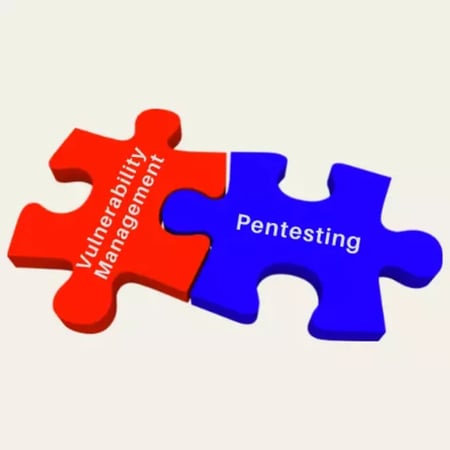This article was refreshed in January 2023.
A vulnerability assessment is the process of organizing, classifying, and prioritizing vulnerabilities within a particular system. A penetration test is a security assessment, where expert testers simulate cyberattacks on an application or network to identify vulnerabilities.
A vulnerability assessment and penetration test contain various features that, when combined, bolster security and remediation efforts. For example, both help companies to maintain a high level of security by identifying known vulnerabilities, misconfigurations, and other potentially damaging exploits, but with distinct differences.
Today, we’ll review the specific differences between a pentest and vulnerability assessment. First, we will frame the comparison within the broader context of vulnerability management. This context is critical because of the ever-evolving nature of cybersecurity — using different approaches to identify vulnerabilities is a valuable tactic.
How Do Pentests and Vulnerability Assessments Influence Risk Management?
At a high level, a vulnerability assessment is a point-in-time analysis of how much damage a potential exploit poses to a business. When companies conduct vulnerability assessments on a recurring basis, this is the foundation of a vulnerability management plan.
A penetration test looks at an asset’s security posture at a specific moment in time, but it takes a human approach versus automated tools such as a vulnerability security scanner. A vulnerability scan, pentest, and other assessments are consolidated to develop the vulnerability assessment and eventually support the broader risk management and information security plans.
Comparing: Penetration Test vs Vulnerability Assessment
|
Penetration Test |
Vulnerability Assessment |
|
Pentests focus on identifying vulnerabilities to highlight their risk. |
A vulnerability assessment organizes vulnerabilities to express business risk. |
|
Pentests are manually conducted by a human, in addition to automatic penetration testing tools. |
Vulnerability assessments are often conducted with an automatic scanner and often aren’t exploiting vulnerabilities. |
|
Human-led pentests alleviate most false-positive results. |
Automatic scanned vulnerability assessments often flag false positives. |
|
Pentests are more likely to flag advanced vulnerabilities such as business-logic exploits. |
Vulnerability assessments will often miss advanced exploits. |
|
Pentest costs will often be noticeably higher than automatic scanners, for good reason. |
A vulnerability assessment using a scanner is often cheaper than a human-led pentest. |
Vulnerability Management Process

As mentioned above, a vulnerability management process is the continuous act of conducting a vulnerability assessment.
Another type of activity a business could conduct to support their vulnerability management process would be with a security scanner. These automatic tools discover weaknesses and highlight vulnerabilities, but they often flag false positives and fail to take into account actual business impact.
Businesses can leverage vulnerability management tools to improve their security by implementing a strong management process before pentesting takes place, which makes the results from a pentest more valuable.
Pentesting serves as a critical layer of defense in vulnerability management because vulnerabilities can be overlooked using only an automated scanner approach.
Pentesting requires a variety of expertise, where penetration testers use a hybrid approach of manual testing and automation to not just find surface level vulnerabilities, but fully understand a system and report on vulnerabilities more holistically. This feeds directly into remediation to remove or mitigate the biggest risks.
The State of Pentesting 2021 report found that security teams struggle with active remediation that pentesting can drive, specifically when it comes to the well-known industry vulnerabilities. There can be several reasons for this, including:
- Improper vulnerability management tools
- Gaps in secure development
- Insufficient investment in security awareness and training
- Unpatched flaws due to low perceived impact and/or lack of resources
The most common weaknesses that security teams’ internal checks are known to miss are:

Cobalt’s Pentest as a Service platform offers penetration tests to strengthen security, with the goal for companies to remediate these types of risks smarter and make security stronger.
Pentesting and Pentest as a Service (PtaaS)
Taking pentesting a step further, we have Pentest as a Service (PtaaS). A key takeaway from the PtaaS Impact Report: 2020 is how PtaaS enables more agile testing and closer collaboration between the unique functionalities of security and development teams.
Pentesting is a security assessment followed by an analysis of an asset (web, mobile, or API) using expert methodologies. Trained security professionals aka ethical hackers — like the Cobalt Core — penetrate applications or network security defenses to find vulnerabilities and confirm if a real attacker could exploit them. After pentesting takes place through the Cobalt platform, your security team can expect to receive:
- A comprehensive list of discovered vulnerabilities
- The security weaknesses that pose real risk to the app, network, or environment
- A concluding report with an detailed breakdown of the testing
- Recommendations for remediation and next steps
- Free retest to validate fixes
Pentesting helps maintain the confidentiality, integrity, or availability of data or systems, and continual coverage with frequent, on-demand pentests.
Vulnerability management is a great starting point for security testing, and pentesting takes security to the next level. PtaaS provides the more narrow, targeted approach to the wider picture vulnerability management looks at when viewing potential security threats to an organization.
Cobalt’s PtaaS platform has the necessary tools for your security team to efficiently manage vulnerabilities and mitigate risks. Get started with Cobalt and schedule a demo today.









